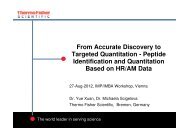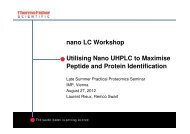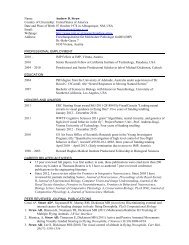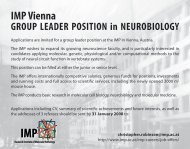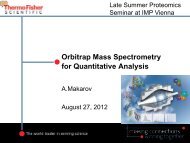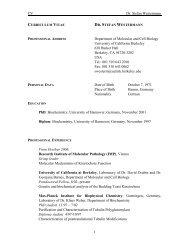IMP Research Report 2002
IMP Research Report 2002
IMP Research Report 2002
Create successful ePaper yourself
Turn your PDF publications into a flip-book with our unique Google optimized e-Paper software.
deletion analysis of the mouse Xist RNA. Using a Cre<br />
recombinase based transgene homing strategy we<br />
have integrated a panel of Xist cDNA constructs bearing<br />
defined mutations into the Hprt locus on the X<br />
chromosome in male ES cells, and characterized the<br />
localization patterns of the resulting RNAs and their<br />
ability to cause chromosomal silencing. Our results<br />
show that chromosomal association of the RNA and<br />
transcriptional repression can be separated by specific<br />
mutations (Figure 2). Silencing is dependent on the Xist<br />
result from the progressive heterochromatinisation of<br />
the inactive chromosome in cellular differentiation.<br />
Results of our experiments are expected to shed light<br />
on the pathway by which Xist RNA localizes in cis to<br />
chromatin and initiates silencing.<br />
Xist mediated silencing in mice<br />
Initiation of Xist mediated silencing is restricted to a<br />
stage where cellular differentiation has not yet<br />
progressed. Conversely, in differentiated somatic cells<br />
Xist expression in general does no longer lead to<br />
silencing despite the ability of Xist RNA to localize to<br />
chromatin. We have generated an inducible Xist allele<br />
to study the initiation of silencing in mouse development.<br />
We are especially focusing our studies on the germline<br />
stem cells, tumor cells and somatic stem cells. We<br />
Figure 2: Chromosomal localization and silencing are mediated by<br />
different sequences of Xist.<br />
repeat A, a conserved repeat sequence located on the<br />
expect to be able to epigenetically classify cells in the<br />
developing mouse as Xist responsive or non-responsive<br />
and thereby visualize this epigenetic transition in vivo.<br />
5-prime end of Xist. Repeat A consists of seven perfect<br />
and one imperfect repetitions of a sequence that can<br />
be folded in two stem loops (Figure 3), whereby each<br />
copy of the motif is separated by a variable spacer<br />
region. Deletion of the repeat A results in an RNA that<br />
still associates with chromatin, but does not affect<br />
transcriptional repression. Localization of Xist RNA to<br />
chromatin is a prerequisite for silencing and is mediated<br />
by functionally redundant sequences that act<br />
cooperatively and are dispersed throughout Xist, but<br />
Functional studies of X inactivation in mice and ES cells<br />
should provide insight into the epigenetic regulation of<br />
gene expression in mammals. It appears that Xist<br />
mediated silencing is a paradigm for a powerful<br />
epigenetic system that is capable of heterochromatinising<br />
an entire chromosome and determines<br />
its specific nuclear localization. It is expected that similar<br />
interactions underlie the regulation of other genes -<br />
however, with less dramatic consequences.<br />
share no homology or common sequence motifs.<br />
We are interested in understanding the mechanism by<br />
which Xist RNA associates in cis with chromatin and<br />
mediates transcriptional repression. To this end we have<br />
initiated experiments aiming at the biochemical<br />
purification of proteins that interact with Xist RNA using<br />
affinity purification and chromatin isolation methods as<br />
competing and complementary approaches. Using<br />
undifferentiated ES cells we hope to specifically identify<br />
factors that interact with Xist RNA in the initiation of<br />
chromosome wide silencing avoiding complications that<br />
Figure 3: Secondary structure predicted for Xist repeat A. The motif<br />
shown is repeated seven and a half times, whereby each copy is<br />
separated by a variable spacer region.<br />
Contact: wutz@imp.univie.ac.at<br />
41




